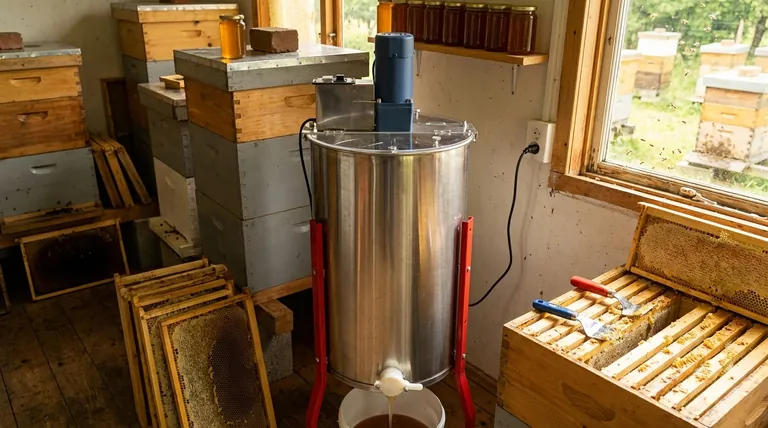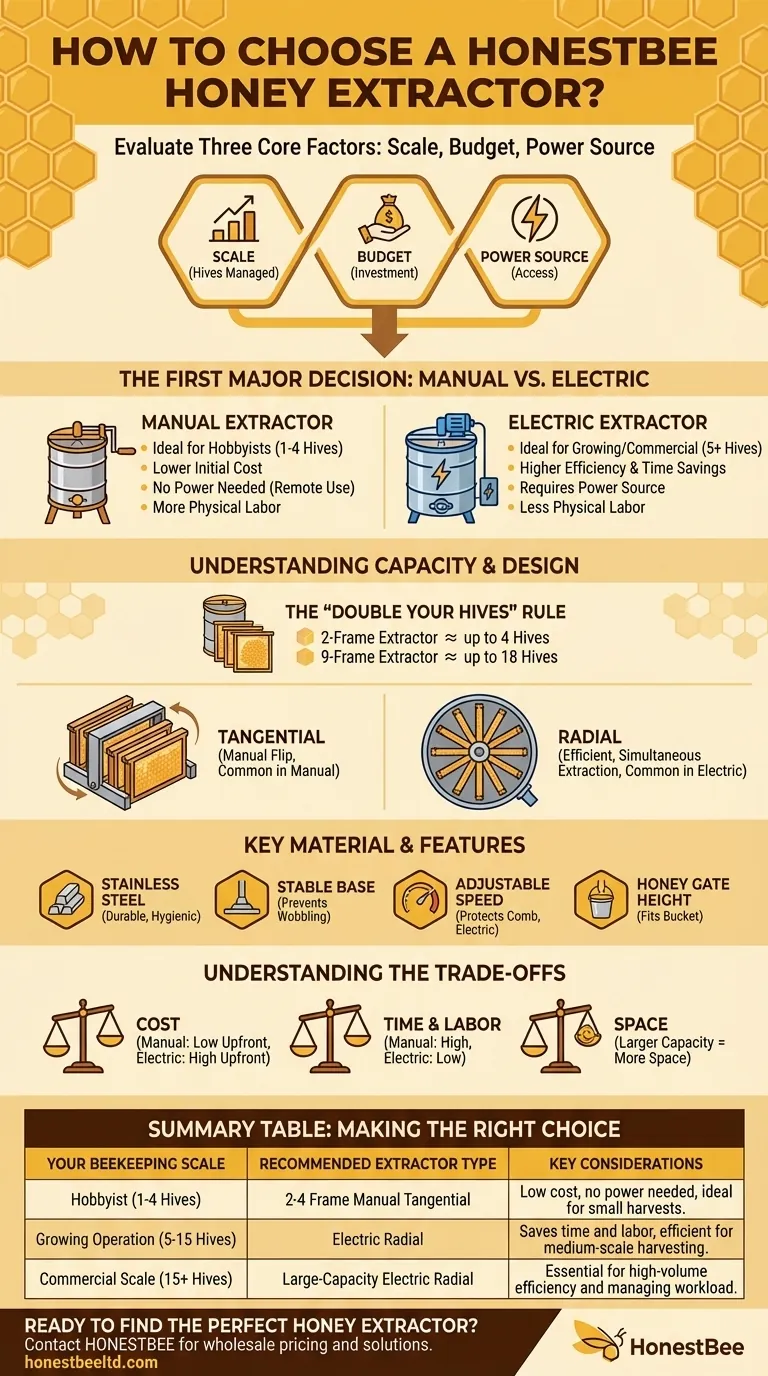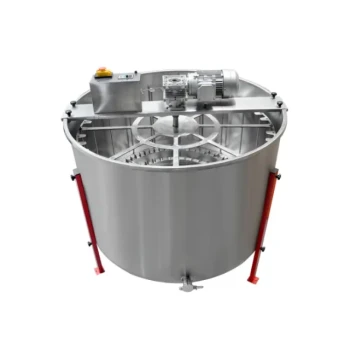To choose the right honey extractor, you must evaluate three core factors: the scale of your beekeeping operation, your budget, and your access to a power source. The number of hives you manage is the most critical element, directly influencing whether a smaller manual unit or a larger electric model is the more practical and cost-effective investment.
The best honey extractor isn't the most expensive or feature-rich model; it's the one that correctly matches the size of your apiary. Your primary goal is to align the machine's capacity and power source with the number of frames you need to process efficiently.

The First Major Decision: Manual vs. Electric
The most fundamental choice you will make is between a hand-cranked manual extractor and a motorized electric one. This decision directly impacts your cost, time investment, and labor during extraction.
When to Choose a Manual Extractor
A manual extractor is an excellent, cost-effective starting point for hobbyist beekeepers. They are ideal for those with just a few hives.
The primary benefits are a lower initial cost and independence from electricity, making them perfect for extracting honey in a remote shed or barn.
When to Choose an Electric Extractor
An electric extractor is the clear choice for beekeepers managing more than a handful of hives, typically ten or more. The motor saves a significant amount of time and physical labor.
While the upfront cost is higher, the efficiency gains are substantial, making it a necessary investment for any medium to large-scale operation.
Understanding Extractor Capacity and Scale
Beyond the power source, the size and design of the extractor determine how many frames you can process at once. This is the key to matching the equipment to your workload.
The "Double Your Hives" Rule of Thumb
A useful guideline is to choose an extractor that can hold a number of frames equal to about half your total number of hives.
For example, a 2-frame extractor is generally suitable for an apiary of up to four hives. A 9-frame extractor could comfortably serve an operation with up to eighteen hives.
Tangential vs. Radial Design
Extractors come in two main designs. Tangential extractors hold frames with one side facing outward, requiring you to manually flip them halfway through to extract honey from the other side. They are common in smaller, manual models.
Radial extractors position the frames like spokes on a wheel, allowing honey to be extracted from both sides simultaneously using centrifugal force. This design is far more efficient and is standard in larger, electric models.
Key Material and Design Features
Durability and ease of use are critical for equipment that will last for years. Paying attention to construction and features will prevent future frustration.
Why Stainless Steel is the Standard
Stainless steel is the preferred material for honey extractors. It is highly durable, will not rust, and is easy to clean and sanitize, ensuring the quality of your honey.
While some smaller, budget-friendly models may use plastic, a stainless steel tank is a wise long-term investment for any serious beekeeper.
Other Features to Consider
Look for a model with a stable base or legs to prevent it from wobbling during operation. For electric models, adjustable speed controls are valuable for gently starting the spin and preventing damage to delicate new comb. Finally, consider the height of the honey gate (the spout) to ensure it's high enough to fit your bucket underneath.
Understanding the Trade-offs
Choosing an extractor is a balancing act between cost, convenience, and scale. Being aware of the compromises is key to making an informed decision.
The Cost Factor
Manual extractors have a significantly lower upfront cost, making them accessible for beginners. However, if your apiary grows, you may quickly find yourself needing to upgrade, turning that initial savings into a sunk cost.
The Time and Labor Equation
The primary "cost" of a manual extractor is your time and physical effort. What might take a few hours with a small electric model could take a full day of demanding work with a hand crank.
Space and Storage
Larger-capacity extractors are faster but also take up considerably more storage space. Ensure you have adequate room for the unit's footprint, especially for a larger radial extractor that may serve 20 or more hives.
Making the Right Choice for Your Apiary
Ultimately, your decision should be guided by a realistic assessment of your current needs and future beekeeping goals.
- If your primary focus is a small hobby (1-4 hives): A 2-frame or 4-frame manual tangential extractor is the most practical and economical choice.
- If your primary focus is a growing operation (5-15 hives): An electric radial extractor is a worthwhile investment to save significant time and labor.
- If your primary focus is efficiency at scale (15+ hives): A large-capacity electric radial extractor is essential for managing your workload effectively.
Investing in the right extractor from the start will save you time, labor, and frustration, making honey harvest a rewarding experience.
Summary Table:
| Your Beekeeping Scale | Recommended Extractor Type | Key Considerations |
|---|---|---|
| Hobbyist (1-4 Hives) | 2-4 Frame Manual Tangential | Low cost, no power needed, ideal for small harvests. |
| Growing Operation (5-15 Hives) | Electric Radial | Saves time and labor, efficient for medium-scale harvesting. |
| Commercial Scale (15+ Hives) | Large-Capacity Electric Radial | Essential for high-volume efficiency and managing workload. |
Ready to find the perfect honey extractor for your operation?
At HONESTBEE, we supply durable, high-performance beekeeping equipment tailored for commercial apiaries and distributors. Our range of manual and electric honey extractors is designed to maximize your harvest efficiency and ROI.
Let our experts help you select the ideal model for your scale and goals. Contact us today for wholesale pricing and equipment solutions that drive your business forward.
Visual Guide

Related Products
- electric honey extractor honey centrifuge 3 frame honey extractor stainless steel honey frame extractor
- Electric 8 Frame Honey Spinner Extractor Equipment for Beekeeping
- 8-Frame Electric Self-Reversing Honey Extractor Spinner for Commercial Honey Extraction Equipment
- 2 Frame Stainless Steel Manual Honey Spinner Extractor for Beekeeping
- 40 Frame Commercial Electric Honey Extractor for Beekeeping
People Also Ask
- How does an electric honey extractor work? Automate Your Harvest for Maximum Efficiency
- What happens to the frames after spinning in the extractor? A Guide to Sustainable Frame Management
- What is a honey extractor and why is it beneficial for beekeepers? Boost Hive Health & Harvest Efficiency
- What are the two main types of honey extractors? Choose Between Tangential and Radial for Your Apiary
- What are the main processes involved in honey processing? From Hive to Jar, A Complete Guide



















